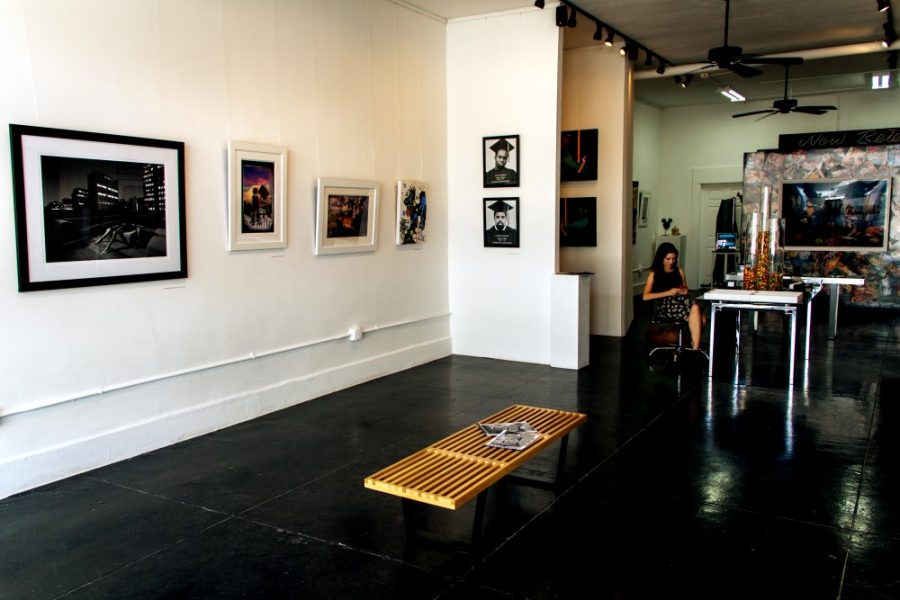Stark white walls offset inky black flooring. Indiscernible pop music emanates languidly across the room. A bench, low-slung and undoubtedly designed with the Bauhaus in mind, sits squarely in the center of the space. From the vantage of the bench unfolds an adroit conversation on race, albeit a visual one. The Moen Mason Gallery “BACKTRACK: Narratives on Race” exhibition, unlike their gallery space, is not a distinctly black and white consideration.
Opened Aug. 1 in the gallery which opened downtown Tucson in November 2014, “BACKTRACK: Narratives on Race” features several international artists, including EJ Brown, Christopher Classen, Susan Copich, Najee Dorsey, Jonathan Hobin, Michael Meyersfeld, Matt Straub, Oscar Sancho Nin and Essi Zimm. Curated by Mitch Moen, artistic director for Moen Mason Gallery, and Marie Rodriguez, recent UA graduate and gallery associate, the exhibition lacks no social relevance. In face of events at Ferguson, Mo., Baltimore, and Oakland, Calif., the show addresses issues and conceptions of race—specifically contemporary ones—with both white and black artists as a conduit.
“Exhibitions such as these are important, because the conversation is mostly happening in the media,” Moen said. “Depending on the source you are tapping into, whether it be left or right, dictates the story you are receiving. BACKTRACK was an opportunity to have that conversation in a neutral environment. We specifically told each and every artist that whether we agreed with their position on race or not, we would post their unedited narrative.”
Featuring a wide range of artists, whose works vary both in medium, stylistic choices and opinion, the work exhibited in “BACKTRACK: Narratives on Race” is ultimately a reflection of contemporary artists responding to contemporary issues. As one of the only contemporary galleries to inhabit downtown Tucson, where the artists supported by Moen Mason Gallery are successful, currently working artists, the show deposits an experience infrequently obtained in an art-viewing context. Mainly because it’s contentious.
“Some of the white artists were hesitant to be in a show like that,” Rodriguez said. “Because it is a controversial issue, I can understand it maybe being perceived as something exploitive, in terms of its relevancy.”
In a post-recessionary, Internet-laden society, a majority of people don’t collect art or frequent physical art-viewing environments. It is a tough economic moment for galleries and museums who, in order to stay afloat, cling to old narratives, digestible ideas, and put forth shows and artists whose work is recognizably “high-art.”
“BACKTRACK: Narratives on Race” is controversial because it doesn’t do that. It broaches difficult topics using alternative artists.
“People don’t know that about some of these artists, but these are huge names,” Rodriguez said.
Such names include Canadian photographer Hobin, whose photo series “Cry Babies” is on display in part at Moen Mason Gallery, and has been featured in Vice, Juxtapoz and The Huffington Post. The show also features upcoming artist Brown’s “The Mugshot Series”: a series of photographs depicting his friends in their graduation garb, posing for mugshots with police booking slates stating their majors. “American Blood Diamond” by Los Angeles artist Classen, a work exclusive to Moen Mason Gallery, is based on a fictionalized American company, where fragments of glass from retail, automotive, or bottles, following social unrest, are sold as conceptual gemstones.
“We didn’t fill the exhibition roster based on race, we filled it with artists who had something to say on the matter,” Moen said. “While we did feature white artists, we also included powerhouse artists Najee Dorsey and EJ Brown to the mix as well. Initially, Christopher Classen received a lot of negative feedback in relation to his submissions simply because he was white. But the art patrons who attended the show adored his blood diamond works. Not because he is white or black, but simply because he is a brilliant artist.”
“BACKTRACK: Narratives on Race” arrives at a socially poignant moment, but quietly. It discreetly introduces considerations on race that sublate with daily life.
“Just because the media is done talking about it for now, because there hasn’t been a recent shooting, doesn’t mean it’s not still a problem,” Rodriguez said. “That’s one of the reasons why people make art, to get issues out to the public. It’s a beautiful way to raise topical issues. Just like what Jonathan Hobin does with his work, to raise issues about the media, this show is sort of keeping the issue of race and the problems that go along with it, within the media, within society.”
Up until mid-October, “BACKTRACK: Narratives on Race” begs a few questions: Who is talking about race? Is it appropriate for white artists to represent a conversation on race? How does the conversation change when it’s visual and nonverbal? How are social issues constructed in an art-viewing environment?
“BACKTRACK is particularly an amazing exhibition because it’s such a modern issue, but it’s seen [in] a very artistic, totally different way,” said Lauren Burgheimer, assistant at Moen Mason Gallery. “It’s not even about one’s skin color or one issue; it’s about issues that are relevant the world over, and we bring it right here to Tucson.”
The exhibition, vacillating between black and white, sits in a strikingly grey arena.
Follow Audrey Molloy on Twitter.









